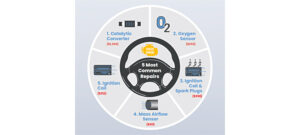More than $22 billion in aftermarket distribution shifted among the five major aftermarket channels in the U.S. between 2011 and 2021
Fort Wayne, Ind.—More than $22 billion in car and light truck products, at user-price, shifted among the five major aftermarket channels in the U.S. between 2011 and 2021.
That is the largest car and light truck product shift in aftermarket product distribution since World War II and reflects a wide range of market factors: changes in DIFM and DIY outlet product volume, the rapid expansion of the foreign nameplate aftermarket, and eCommerce growth, to name only a few, according to The Lang Aftermarket iReport.
“Two of the five major distribution channels expanded their product share over this 10-year span, while three were losers,” stated the analysis. “These changes in channel share mark an inflection point in the evolving strength of distribution channels that will likely continue for a number of years.”
The following are the report’s key takeaways regarding the shift.
Channels Expanding Product Volume
Together, the integrated and import channels added nearly $17 billion in product sales between 2011 and 2021. These were the only two channels to expand their product share over this 10-year span. The integrated channel increased its product share by nearly 3.0 percent between 2011 and 2021, a share gain of nearly one-tenth, followed by the import channel, which added 1.5 percent to its share, expanding its product share by one-fourth.
— Integrated Distribution Leads in Product Growth
The integrated channel is characterized by product ownership, or franchised affiliation, not changing hands from the time they are purchased from manufacturers to their sale to an installer, DIYer or another end-user.
The integrated channel boosted its car and light truck product sales by nearly $13 billion at user-price between 2011 and 2021. This unprecedented growth represented more than half of light truck aftermarket product expansion during those 10 years.
— Import Channel Product Gain
The import channel, which includes import warehouses and import jobbers, recorded the largest percentage increase in product volume (as a share of its 2011 sales) over the past 10 years.
The rapid expansion of the foreign nameplate aftermarket has fueled the growth of the import channel, which has benefited from the expansion of direct-selling import warehouses and the surge in the foreign nameplate share of vehicles in operation (VIO).
Two-step import warehouses are at the distribution heart of the fast-growing foreign nameplate market, as import channel product sales increased by more than $3 billion at user-price between 2011 and 2021. This represents more than a 50 percent gain in the import channel’s product volume.
Channel Share Losers
Over the past 10 years, three channels shrank in light vehicle product distribution share: traditional, OE, and specialized. However, only the specialized distribution failed to record an increase in product volume between 2011 and 2021. The Specialized channel shrank nearly 3.5 percent in product share between 2011 and 2021, while the OE channel and traditional channel each declined approximately 1.0 percent in car and light truck product share.
— Traditional Channel
The traditional channel, with its multi-tiered distribution involving traditional warehouses and traditional jobbers, recorded the second-largest product growth between 2011 and 2021.
Though despite adding more than $4 billion to its product volume, the traditional channel accounted for a smaller 2021 car and light truck product share than it held 10 years earlier. The traditional channel is engaged in both two-step and three-step aftermarket distribution. Two-step distribution achieved a higher product growth rate than its three-step distribution over that time period.
— OE Channel
The OE channel consists of OE suppliers (and their affiliates) shipping products to vehicle dealers across the country. Although the OE channel accounted for a lesser share of light vehicle product distribution in 2021 than 10 years earlier, its nearly $3 billion increase reversed a decline in product sales from 2007 through 2017.
— Specialized Channel
The specialized channel is engaged in two types of distribution: one that focuses on a limited array of products, and another that is involved in certain aftermarket sectors. Specialized distribution is the only major channel that suffered a decline in product volume between 2011 and 2021.
Continuing Product Sales Shift
Car and light truck product shifts among major distribution channels will continue and most likely accelerate over the next five years.








Comments are closed.